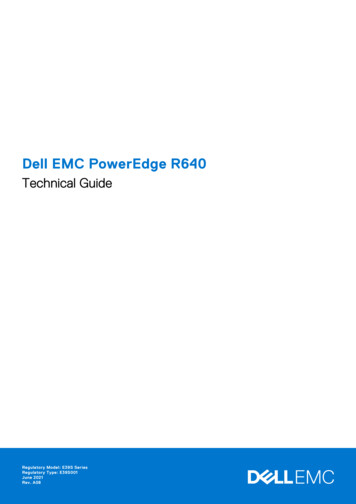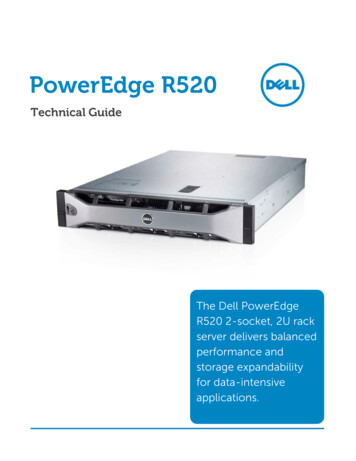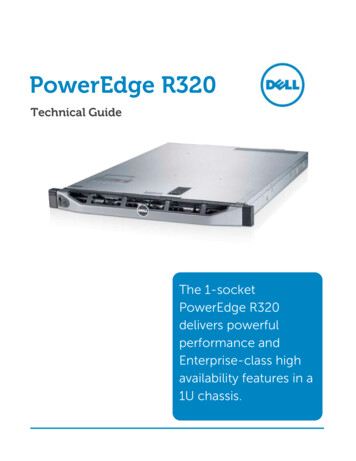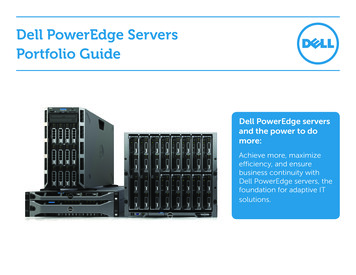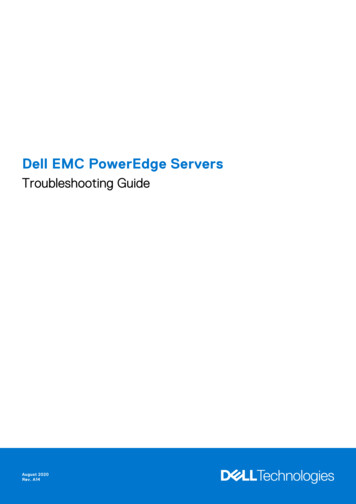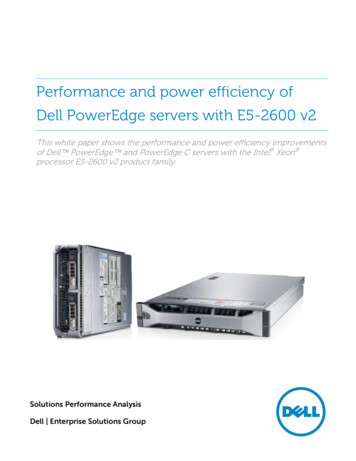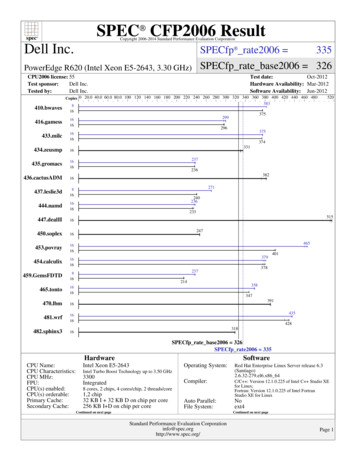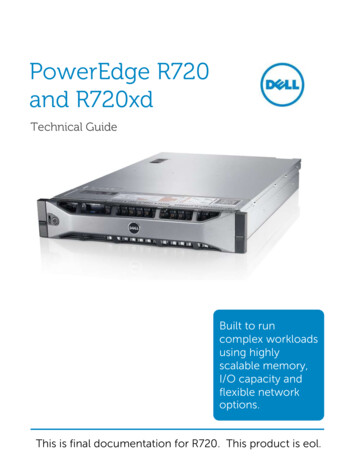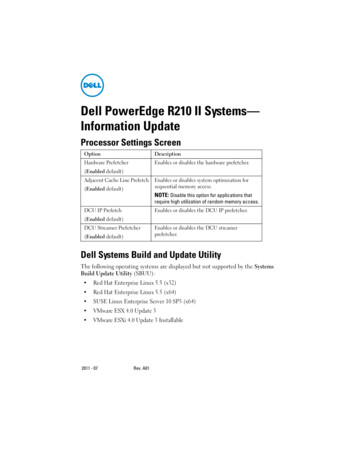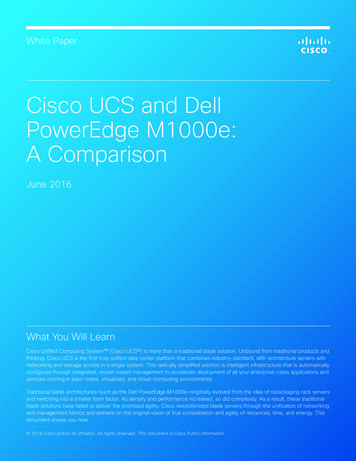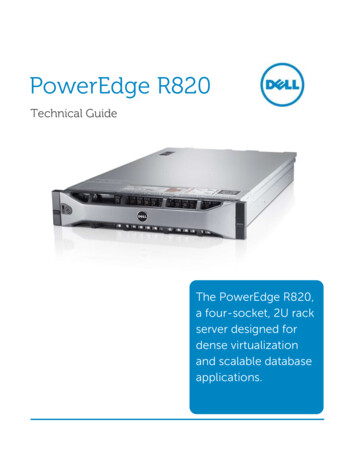
Transcription
PowerEdge R820Technical GuideThe PowerEdge R820,a four-socket, 2U rackserver designed fordense virtualizationand scalable databaseapplications.
This document is for informational purposes only. Dell reserves the right to make changes without furthernotice to any products herein. The content provided is as is and without express or implied warranties of anykind.Dell, the DELL logo, PowerEdge, EqualLogic, PowerVault, OpenManage, KACE, and ReadyRails are trademarksof Dell, Inc. Intel and Xeon are registered trademarks of Intel Corporation in the U.S. and other countries.Microsoft, Windows, Windows Server, BitLocker, ActiveX, Internet Explorer and Hyper-V are either registeredtrademarks or trademarks of Microsoft Corporation in the United States and/or other countries. Novell andSUSE are registered trademarks of Novell, Inc. in the United States and other countries. IBM, Tivoli, andNetcool are registered trademarks of IBM in the United States. Other trademarks and trade names may beused in this document to refer to either the entities claiming the marks and names or their products. Delldisclaims proprietary interest in the marks and names of others. Copyright 2013 Dell Inc. All rights reserved. Reproduction or translation of any part of this work beyond thatpermitted by U.S. copyright laws without the written permission of Dell Inc. is unlawful and strictly forbidden.December 2013 Version 5.0iiPowerEdge R820 Technical Guide
Table of contents1 System overview .5Introduction .5Key technologies . 62 System features . 7Comparison of PowerEdge systems . 7Specifications . 83 Chassis views and features . 10Chassis views . 10Chassis features . 124 Processor . 15Processor features . 15Supported processors . 15Chipset .165 Memory . 17Supported memory . 17Memory configurations .18Memory speed .18Memory RAS features.196 Storage . 20Internal storage . 20External storage . 21Storage controllers . 21Optical drive . 22Tape drive. 227 Networking and PCIe . 23Select Network Adapter. 23PCIe expansion . 258 Power, thermal and acoustics . 28Power consumption and energy efficiency . 28Power supply units . 29Thermal and acoustics. 309 Rack rails and cable management . 33Sliding and static rail systems . 33Cable management arm. 3510 Operating systems and virtualization . 36Supported operating systems. 36Supported virtualization . 3711 Dell OpenManage systems management . 38Systems management solutions . 38OpenManage systems management . 39Dell server management operations . 43Appendix A.Additional specifications . 47Chassis dimensions . 47Chassis weight. 47Video specifications . 47Environmental specifications . 48Power supply specifications . 49Rack rail specifications . 50USB peripherals . 50Appendix B.iiiStandards compliance . 51PowerEdge R820 Technical Guide
Appendix C.System board block diagram . 54TablesTable 1.Table 2.Table 3.Table 4.Table 5.Table 6.Table 7.Table 8.Table 9.Table 10.Table 11.Table 12.Table 13.Table 14.Table 15.Table 16.Table 17.Table 18.Table 19.Table 20.Table 21.Table 22.Table 23.Table 24.Table 25.Table 26.Table 27.Table 28.Table 29.Table 30.Table 31.Key technologies . 6Comparing the PowerEdge R810 to PowerEdge R820 . 7Technical specifications . 8Chassis features . 12Security features .14Supported processors .16Memory technologies supported . 17DIMMs supported .18Memory RAS features .19Supported hard drives . 20Supported RAID controllers. 21Supported Select Network Adapter options and features . 24Select Network Adapter selection for racks . 25Supported NICs and HBAs . 26Additional supported PCIe expansion cards . 27Power tools and technologies . 28Power supply efficiency . 30Acoustical performance . 32Supported rack types . 34Primary operating system support . 36Virtual guest operating system support . 37Virtualization support . 37iDRAC7 with Lifecycle Controller functions and benefits . 39Feature comparison for iDRAC7 Express and Enterprise . 40One-to-one and one-to-many operations . 44Supported video modes . 47Environmental specifications . 48Power supply specifications . 49Rail adjustability range . 50Industry standard documents . 51Additional resources . 52FiguresFigure 1.Figure 2.Figure 3.Figure 4.Figure 5.Figure 6.Figure 7.Figure 8.Figure 9.Figure 10.Figure 11.Figure 12.Figure 13.Figure 14.ivFront view without bezel . 10Front view with bezel. 10Back view . 11Internal view . 11LCD control panel . 13QRL location . 13Rack network daughter card . 23750W power supply unit . 30Sliding rails with optional CMA . 33Static rails . 34Dell systems management solutions . 38Systems management server lifecycle . 44System dimensions . 47R820 system board block diagram . 54PowerEdge R820 Technical Guide
1 System overviewIntroductionDesigned to excel at running a wide range of applications and virtualization environments for bothmidsize and large enterprises, the Dell PowerEdge R820 rack server is a compute-intensiveperformance platform with highly scalable memory (up to 1.5TB) and impressive I/O capabilities tomatch. With four Intel Xeon E5-4600 processors and the ability to support dual RAID controllers,the R820 can readily handle very demanding, mission-critical workloads, like data warehousing,e-commerce, virtual desktop infrastructure (VDI), databases and data node high-performancecomputing (HPC).Manage data overloadKeep pace with the explosion of data in the virtual age with the flexible, powerful I/O and storagecapabilities of the R820. Up to 16 internal hard drives and integrated PCI Express (PCIe) 3.0 enabledexpansion slots greatly increase your capacity, while optional hot-plug, front-access Express FlashPCIe solid-state drives (SSD) (up to four) enable performance-enhancing, in-box storage tiering.Moreover, Dell Select Network Adapters, our flexible NIC technology, let you choose the rightnetwork fabric to match your needs without using up a valuable PCIe slot.Accelerate the solutionBoost the performance of your HPC or 2D VDI environment by combining the PowerEdge R820’smemory density with an optional graphics processing unit (GPU) accelerator. Choose from a rangeof GPU options for greater assisted performance.Virtualize more with the R820Maximize your data center’s application capacity by expanding your virtual environment using thePowerEdge R820’s large memory footprint, I/O options, flexible fabric choices and up to 32 cores ina four-processor configuration. Choose an industry-leading hypervisor and take advantage of oursystem management capability to manage both physical and virtual assets. The R820 can also helpmaximize your virtual machines’ uptime using redundant failsafe hypervisors on its internal dual SDmodule. Dell OpenManage Integration with Microsoft System Center for Hyper-V and VMwarevCenter for ESXi can help you easily manage complex virtual environments.Simplified systems management, without compromiseThe Dell OpenManage systems management por
module. Dell OpenManage Integration with Microsoft System Center for Hyper-V and VMware vCenter for ESXi can help you easily manage complex virtual environments. Simplified systems management, without compromise The Dell OpenManage systems management portfolio includes Integrated Dell Remote Access Controller 7 (iDRAC7) with Lifecycle Controller.
